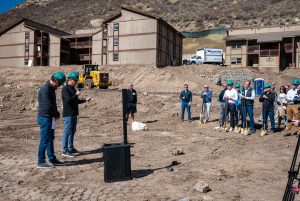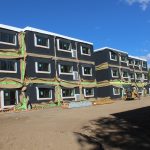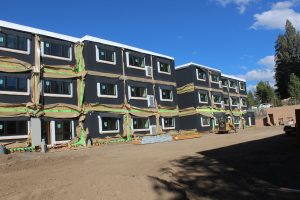Mountain communities weigh in on housing (part 2)
LAKE TAHOE, Calif./Nev. – The unique challenges of creating and maintaining housing in Tahoe have been the focus of the Tribune’s housing series. Now, the Tribune takes a look at other mountain communities: their challenges, triumphs and lessons they’ve learned.
Part 1 of this housing story touches on location and tourism challenges. Part 2 touches on fundi challenges, opinions on housing and lessons learned.
The Tribune spoke with housing managers and planning employees from Ketchum, Idaho (Carissa Connelly); Aspen and Vail, Colorado (Jason Dietz); Jackson and Teton County, Wyoming (April Norton); Hood River, Oregon (Dustin Nielsen); and Mammoth Lakes, California (Marcus Sproll.)
Funding challenges
Finding funding is by far one of the most challenging parts of any endeavor, especially for housing for the missing middle. “There’s a tremendous need across all income ranges,” said Norton. And keeping housing affordable for anyone means often making investments for very little return.
For mountain communities, the cost of construction and materials being shipped to them is extremely high. Norton says that after the great recession, local tradespeople moved away as prices rose, never to return. That means crews come up to Jackson and Teton County from Idaho and Utah, driving up the costs to $500 per square feet for multifamily and affordable housing, $1000 per square feet for single family homes. Not to mention, land costs are also exorbitant.
But two methods seem to work well everywhere: taxation and public/private partnerships. While bonds can be useful, taxation represents a regular contribution, sometimes into dedicated funds. Dietz says that their housing sales tax brings in about $5 million per year. “That’s a lot, but not a lot in the grand scheme of funding,” he said.
So, nonprofits, companies and government entity partnerships are often needed to leverage funds and provide capital that otherwise would be inaccessible. “Creating housing requires a subsidy,” said Dietz. “Government entities can add value by bringing the land, then we can leverage local funds from the general fund or other places with the help of these partnerships.” Dietz cited that the Southbase project used tax-exempt project revenue bonds, made their project attractive through a higher debt coverage ratio and collateralized their golf course.
In Vail, there’s also a real estate transfer tax and a real interest in an STR excise tax to bring more for housing funds. “To get housing, you have to take the risk out of permitting and entitlement and building. How much subsidy can you bring to the table?” asked Dietz.
Aspen’s real estate transfer tax “hasn’t dampened the desire or resale value of houses,” according to Richards. She sees the tax as a substantial funding source, along with their sales tax, which has 25% directed towards housing.
While Aspen and other places in Colorado have these real estate taxes, they’re no longer permitted in the state otherwise. But Colorado has major support in terms of state involvement.
Oregon too, has supported Hood River’s rapid growth and changes. It has followed in California’s footsteps by removing regulatory barriers and adjusting minimum standards. Hood River has adjusted its codes in response to these changes, but Nilsen says Oregon is “very ambitious” in the housing sphere.
“The state has provided assistance with resources when we’ve requested it, and they see what we’re doing as a pilot and possible roadmap,” said Nilsen. Hood River’s construction excise tax, one of the first in Oregon, sets aside funds from market rate construction for affordable housing, buying property and soliciting developers.
Hood River also has an urban renewal overlay, which takes increments from developments to focus on redevelopment, infrastructure and activating spots for housing. “Oregon has been pretty supportive of these creative solutions. They have strict measures on the growth of taxes, but they invest in our most ambitious projects.”
California has also been supportive of housing, though the state has much focus on those at the 80% area median income and below. Low-income tax credits and partnerships with land trusts and private partners made projects like Sugar Pine Village possible. But Sproll says that the missing middle needs funding for new construction too. “It’s one of the most challenging issues out there,” he said, saying that they are the primary challenge in resort communities.
However, not every state is as supportive. “Idaho cannot raise revenue in a way that is meaningful,” said Connelly. “It’s a property rights state. I wish we could do real estate transfer taxes or vacant home taxes. But there’s a state level assumption that if you build more, it will be affordable, which is not necessarily true.”
Teton County, which is in the top 10 highest income counties according to the American Community Survey, is a challenge for Norton as well. “We have received some state support with regards to tax credits, but we have no state housing trust fund—it fails in the legislature every time,” said Norton. “Our state has chosen to take a pro private property stance.”
Opinions on housing
While there is support for housing in many places, public outreach and understanding where people are coming from is needed to help shape how housing will play out.
Norton said, “There’s a couple different factions of anti-housing people here. Some are opposed to the location, some are anti-growth in these communities and some disagree with government involvement in housing.” She also has to contend with a funded anti-housing group, which she says is paid for in part by wealthy, out of state NIMBYs.
Connelly says that there is often backlash to new construction at any scale, especially because of the attitudes around housing. She sympathizes with the people who say that they teach kids, work in pharmacies and serve the community—yet are treated like outsiders.
Connelly lives in an accessory dwelling unit (ADU) in Ketchum and says people have accused her of lying about living and working there. They’ve also told her in no uncertain terms that they aren’t interested in multi-family homes, as there’s a pervasive rhetoric that people looking for housing are “parasites.” And these people are often speaking up more at public meetings.
Other places have more support by leagues, but are concerned with the environmental ramifications of more building in rural areas, especially those near protected lands. Still more wonder about what the change will bring to their towns.
The character of the place people live has long been a major consideration that, for some, feels encroached on by housing. But the threats that many worry about, like out-of-towners filling up new housing, is actually impacting people who have lived there for a long time.
“People that live here do so because they love the place they live. Change can feel a bit like a threat to that quality of life and small-town feel,” said Nilsen. “But this is a market-driven issue beyond the scope of the individual. This threat is really to long-term residents who are displaced or multi-generational families who can no longer afford to live here, and I fear that they won’t really be able to unless we continue creating housing as a change for the public interest.”
“What is the purpose of affordable housing?” asked Richards. “In a lot of ways, it’s determining your community. Is it all second homes with commutes 40 miles away? Is it just about a workforce? Is it just to fulfill employment? Or do you want to have a community?”
Lessons learned
Major lessons boil down to dealing with the challenges of these mountain communities, with a primary driver being money. “Housing should be something that’s funded annually, like roads,” said Richards.
Solutions should also fit the unique profile of a mountain town, since one size truly doesn’t fit all. Nilsen said, “It’s part of our job to choose the correct fit within our state and what the city is trying to accomplish.”
While low-income tax credits have been invaluable in funding Sugar Pine Village, Richards says that they don’t plan to pursue it further in Aspen. “As time passes and wages increase, but the guidelines don’t change, we end up with empty units we are unable to fill because applicants ‘make too much money.'”
Similarly, while ADUs have had some success in Idaho and California as housing options, the reticence in Nevada and other private property prioritizing states means it might not work everywhere.
But working within state and federal legislation can lead to creative solutions. Jackson County has systems that allows them to manage housing paid for by employers in the area, taking the onus off of employers to clean, care for or lease their properties.
Other places promote housing through zoning, streamlining processes or offering incentives to developers that make it easier, not harder to create housing. Some have suggested taxes to fund them or even tax exemptions that could be discussed.
Everyone acknowledges that so many stages of life are more complicated in these rural communities—being single, having a family and aging all present their own issues. But they’re trying to address those too with local preferences for workforce, increasing multifamily dwellings, preserving housing and in some cases, creating loans that help homeowners make accessibility fixes.
Eli Ramos is a reporter for Tahoe Daily Tribune. They are part of the 2024–26 cohort of California Local News Fellows through UC Berkeley.
Support Local Journalism


Support Local Journalism
Readers around Lake Tahoe, Truckee, and beyond make the Sierra Sun's work possible. Your financial contribution supports our efforts to deliver quality, locally relevant journalism.
Now more than ever, your support is critical to help us keep our community informed about the evolving coronavirus pandemic and the impact it is having locally. Every contribution, however large or small, will make a difference.
Your donation will help us continue to cover COVID-19 and our other vital local news.










